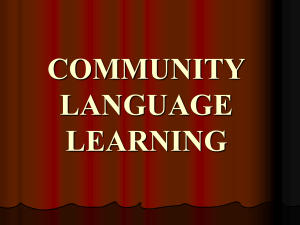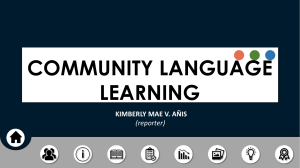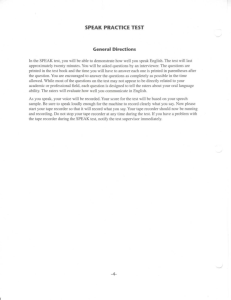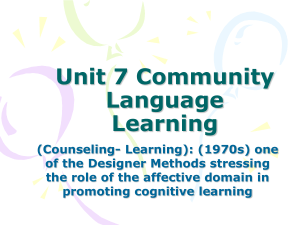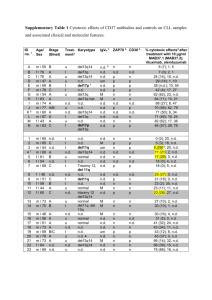COMMUNITY LANGUAGE LEARNING (CLL)
advertisement
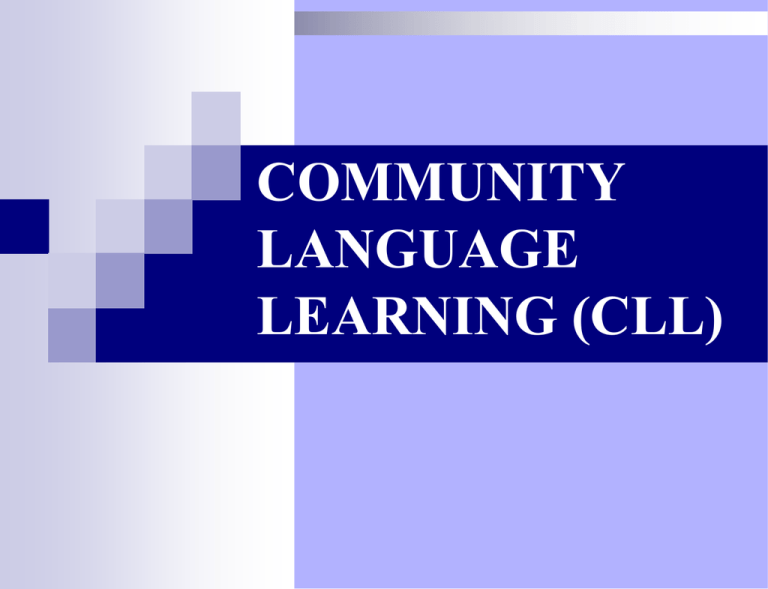
COMMUNITY LANGUAGE LEARNING (CLL) Background developed by Charles Curran in the 1970s primary insights from Rogerian counseling theory counselor client (knower) teacher (learner) student Maskowitz’s Humanistic Techniques which engages the whole person: • blend what students feel, think, and know with what they are learning in target language • self actualization and self-esteem • help to foster a caring climate • emotions and feelings as well as linguistic knowledge and behavioral skills Language Alternation; (another language teaching tradition which CLL is linked ) - Mackey: A message, lesson or class is presented first in the native language and then, in the target language before overhears. Approach; Theory of Language; the social-process view of language + the Interactional view of language La Forge’s Alternative Theory; beyond the structuralist view of language which means Language as a Social Process. Communication; Not just a message, Not just the uniderectional transfer, Speaker = listener = subject and object of the message. Verbal Sender Message Receiver <the information-transmission model> Verbal Sender Message Receiver < the social-process model> “Language is persons in contact”. “Language is persons in response”. La Forge The interactional view; - interactions between learners unpredictable - interactions between learner and knower dependent and independent Stages; in stage 1; dependent in stage 2; self-assertive in stage 3; resentful & indignant in stage 4; tolerant in stage 5; independent Theory of Language Learning Whole-person Learning ( cognitive and affective ) -a holistic one -analyzed into five stages Whole person learning stages; 1- feelings of security and belonging 2- independence 3- speaking independently 4- mature enough to take criticism 5- improving the knowledge of linguistic Convalidation or Consensual Validation S stands for security A stands for attention and aggression R stands for retention and reflection D stands for discrimination “SARD” By Curran Design - Objectives encouraging the students to take more responsibility learning how to learn from one another using the target language communicatively The Syllabus the teaching of oral proficiency a topic based course progression emerging from the interaction between learners and teachers detailed and specific grammar and lexical points isolated by the teacher Learning Activities Translation Analysis Group work Reflection and observation Tape-recording Listening Transcription Free conversation Roles of Learners Being a member of the community, Listening carefully Telling messages independently Repeating messages without any hesitation Expreesing feelings, frustration Being counselor of other learners Roles of Teachers Encourager Supporter Monitoring relationship Politely criticiser advicer Instructional Materials a textbook isn’t necessary developed by the teachers as the course develops projector, tape recorder scripts for conversations developed by the students. Procedure informal greeting statement of the goals and guidelines sitting in a circle conversations and messages given by the student in the L1 Translation of it into the target language by the teacher repetition for the tape recorder Replaying the tape recorder for refreshing what have learned by repeating Reflection Elements of Spelling, Grammar, Capitalization Asking questions about the lesson Copying sentences from the board with notes on meaning/usage. What is the role of the native language in CLL? Enhancing the security Providing a bridge from the familiar to the unfamiliar Making the meaning clear Weaknesses a lack of grammatical syllabus unclear objectives focus on fluency rather than accuracy difficulty in evaluation What areas of language skills are emphasized? - Culture is the integral part of language learning, and language is for creative and critical thinking. - The most important skills are understanding and speaking the language and then, reading and writing with reinforcement.
